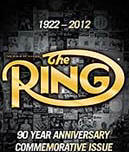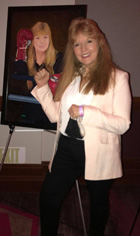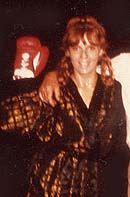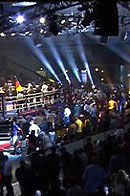Heather Hardy: I started kickboxing to get in shape after my daughter Annie started school. It was just a few weeks in that one of the instructors asked me if I wanted to try a match, so I did… and I won! It was the most incredible feeling ever! It was like the missing piece to my puzzle. I started getting seriously into boxing when I came to Gleason’s and was working with Devon. I knew I loved it, but it was he who convinced me that I could make it. Together, we have been unstoppable.
JM: How does your family feel about your career choice, any worries about the possible long term dangers of the sport?
HH: My family has been incredibly supportive. I live with my sister, and we both take care of our two kids. She stays at home while I work. We rely on each other. I think there are risks associated with any job, we can’t let all the risks keep us from doing things we love to do every day.
JM: You have some solid credentials as an amateur, but you come from a kick boxing background. How difficult was it to make the transition to pure boxing?
HH: It was extremely difficult to make the transition from kickboxing to boxing. I was kickboxing out of a karate dojo that practiced a lot of old school techniques. Their focus was on discipline, as well as being tough and strong. Devon taught me to appreciate the art and science of boxing, and to understand what I’m doing in the ring at a much deeper level….and yes, in the beginning I would always instinctively pick my legs up to kick my opponents.
JM: Tell us about your team: your gym, manager, trainer, promoter, etc.
HH: My gym is Gleason’s Gym in Brooklyn, N.Y. Gleason’s became my second home and Bruce (the owner) like another dad. When I had no place to go, Bruce opened the doors at Gleason’s to me and everyone inside became my family. Devon Cormack is my coach, my business partner, and manager. He handles all aspects of my boxing, and most aspects of my life that I wouldn’t trust with anyone else. Lou DiBella is my promoter, and because he took the chance of putting me on his card for my pro debut, he will always be special to me.
JM: …and that made you decide to remain with Lou DiBella as your promoter?
HH: We signed with Lou because he televised my first two professional fights before we were even contracted with him. He showed he was willing to give me a chance and more exposure when I was unknown and unsigned. He is a true supporter of female boxing and a genuinely nice guy.
JM: You’re off to a solid start, undefeated at 6-0 (1 KO), but your career got off to a rocky beginning early on when you were knocked down in the first round of your debut by Mikayla Nebel. What went through your mind at that point?
HH: I knew I had to hustle in order to pull out that win! As the ref was counting, I remembered thinking I needed to beat the crap out of the girl in front of me.
JM: You also just scored your first stoppage win (TKO 4 over Cassie Trost in July), how did that feel to get that first knockout?
JM: So what’s your training regimen like, do you alter it between fights?
HH: My training never changes. I run anywhere between 4- 8 miles a day, I weight train, and I box a minimum of two hours a day with the coach. I know I have a lot of room for improvement, so there is not much rest. We are always working on something.
JM: When preparing for a bout, do you look for any information or video footage of your opponents, or do you prefer to just get in the ring on fight night and adjust as the fight moves along?
HH: Devon looks up the girls to get an idea of who they are, and what would be the best way to approach the match, we don’t ever go into a fight with a fixed plan through. I make sure my body is in shape to give the crowd hard, non-stop rounds. Adjustments are made after every round according to what’s needed.
JM: You’ve suffered a few unfortunate events outside of boxing, a house fire and flooding from hurricane Sandy that dramatically affected your life. How did you manage to stay focused on your career during those tough times?
HH: Yes, life is hard for everyone. My great grandma always told us that “God makes the back to fit the burden”. I took everything in stride. First there was a fire, then a flood, so my daughter and I were homeless twice over the course of about four months, but we are ok now!
JM: Aside from boxing, you also work with two charities, tell us about them and how did you get involved with them?
HH: Yes, I work with a few charities. First, I teach a group of inner city kids at Gleason’s Gym that are part of a program called, “Give a Kid a Dream”. The program was started by Bruce Silverglade (owner of Gleason’s Gym) and Perry D’Alessio. The coaching is run by head boxing instructor, Devon Cormack. The kids are recommended by teachers, counselors, and/or parole officers, and Bruce takes them into the gym and offers them a place to train at no cost. We hope that they apply the disciplines they learn in boxing to their everyday lives, and we have seen much success. Some of these children have become so close to us, they are like our own kids. I also work with “We Care N.Y.”, a charity that oversees relief aid to the tri-state area. Right now the focus is on the victims of Sandy, and since my family’s home was lost in that hurricane, I am happy to help the other residents in my community connect with the resources available in order to get their lives back together. My neighborhood was under seven feet of water last October. I am now in the process of pairing up with Dan Foster, a colon cancer survivor, who started a program called “Knockout Cancer”. I am excited to be a part of a few fundraisers this fall.
JM: You’re the subject of a documentary film, “Hardy.” How did you get involved in this, and how deep does the film go into your life outside of boxing?
HH: Natasha Verma, the director, contacted me about a year ago and pitched the idea of doing a film telling the story of the struggles a female boxer faces trying to make a living in this competitive sport. I was honored that she wanted to use me as her subject, and am very pleased with what we have done so far. The film does get into my personal life a bit, but I think I have a similar story to a lot of women who do what I do. I truly believe everyone fights hard through life. We all have had something or some experience that we can call up on when we are in that ring, toe-to-toe with an opponent that motivates us and pushes us through.
JM: New York boxers, Brooklyn boxers, and especially Irish boxers, are known to have a strong and loyal fan following. How much of a role do the fans play in your career? How much of a role do the critics play?
HH: Everyone knows New York fans are the best fans! I love them, and it’s an honor to have such a large support system of people who believe in what you can do. The Irish community has embraced me as well, and it has been a real honor to have John Duddy in the crowd at all my fights. They all push me to work harder. As for my critics, no one has ever been harder on me than I am on myself. I am my own worst critic.
JM: What do you think about women’s boxing finally making it in the Olympics?
HH: Women’s boxing in the Olympics was a huge first step. Seeing the other countries along with the three American girls participating in London was one of the proudest times I’ve had being in the sport. Still, it is quite disappointing to see that after such an impressive showing, there aren’t going to be any additions to the three weight classes is 2016. I was in the amateurs leading up to, and through the competitions for Olympic trials. I saw, first hand, the tremendous amount of talent overflowing in the 112, 132, and 165 weight classes. Girls were practically starving them-selves, emaciated, getting on the scales throughout the seven day tournament. I got to see some of the most epic fights, and saw true Olympic talent lose a match by one point and having to go home because only three girls were picked for the team. We proved ourselves. The girls went to the Olympics and made their countries proud. It is unacceptable to me that in 2013, we still have to be fighting for equal rights, we should have gotten more weight classes entered for 2016.
JM: Did women’s boxing in the Olympics ever give you second thoughts about turning pro?
HH: We’re in the Olympics, but women’s boxing still isn’t well received in the United States as it is in South America or Europe for example, where the majority of the women’s mega-matches take place. When I came to Gleason’s in late 2010, I was already 28; women’s boxing in the Olympics was still a topic for discussion, and not a set plan. I knew I wanted to be a world champion so that became our goal from my first amateur bout. After I won Nationals at 125 lbs., we decided to give the Olympic trials a shot. I was underweight, but wanted to see how I would fare against the bigger, more experienced girls at 132 lbs. who had spent years in the amateurs waiting for the opportunity. I only made it to the semi-finals, but I was happy to have had the experience and to have been a part of the history. Since my weight class wasn’t being included, and I was already getting up there in years, we didn’t set our hopes on Olympic dreams.
JM: As you stated, women’s boxing isn’t as well received in the U.S. as it is in other parts of the world. How do you feel knowing that you may have to leave the country to get a world title shot or a real big fight at some point?
HH: There are some very talented, world-title holding American women who are unknown to the general public. Until we get the chance to be seen on a larger scale, people will still think that female fighters just fight in bikinis and pools filled with Jell-O. Outside of the States, other countries have seen that the women are just as talented, just as skilled, and just as tough as their male counterparts. They have accepted them and have rewarded their female boxers with shows in venues that allow the world to see and appreciate their boxers. Unfortunately, we are still waiting for this country to take notice, and though in 2013 we should not still be pleading our case for equal rights; we have to continue doing the work and try to bring more awareness to the public. While I don’t mind leaving the country to fight for exposure and a world title, my main concern and effort is to bring about change so one day I can get that big fight right here.
JM: What’s coming up next for you? Do you have any fights scheduled?
HH: We’re talking it out with the team, and I’m ready go. We are hoping to have an opponent for next month’s show at the Casino in Queens.
JM: Is there anyone fighter you have your eye on at the moment?
HH: Nope, I focus on nothing but improving my skills in the ring. With just six fights under my belt, I realize I still have to work my way up the ranks to qualify for anything, so that’s what we are doing.
JM: Is there any one fighter you’re focusing on as a long-term goal?
HH: I have a secret wish list, I think all fighters do. Right now, I’m just trying to win one of my sparring rounds with Alicia Ashley (the WBC super-bantamweight champion). As it stands, it’s Alicia- 6,324,222 and Heather-0. I’ll let you know how it goes as soon as I get my rounds done with her tomorrow ![]()
JM: Anything you’d like to add? Any messages to your supporters and fans?
HH: Thank you to all my fans and supporters for believing in me, buying tickets to all my fights, and helping to encourage me to do my best. The media has been super supportive of me too, and that means a lot to me. You can follow me on Facebook, Instagram, and on Twitter at @HeatherHardyBox.
My questions are now directed to Natasha Verma, Director of the film “Hardy”
JM: What was it about Heather Hardy that made you want her as the focus of your film?
Natasha Verma: “Hardy” is a film about women’s boxing and the issues women face in the sport. Heather is the fighter I decided to tell the story through. As a single mother who is battling it out in her personal life, she uses boxing as an outlet. The way she carries herself, in this male dominated sport, is inspirational. I believe her story will touch many people.
JM: How well did you know Heather prior to filming?
NV: Prior to filming, I did not know her at all. As production progressed, I learned more and more about her. That’s the beauty of the documentary film – it is honest and unfolds in real time. Heather and I are now good friends.
JM: What have you learned about her during the filming?
NV: When I first met her, I had only seen her in training in the gym and fighting in the ring – only the surface of who she is. When I started filming her life at home, in the locker room, and behind the scenes of the fights, I learned how hard she worked and how much was at stake before each fight. Boxers truly pour their heart into the game sometimes without the pay they deserve.
JM: What are your goals and what are you looking to accomplish with this film?
NV: “Hardy” will show viewers what it takes to overcome obstacles and be a female fighter in the industry today. This film will also present a solution as to how other female fighters can raise this sport. After the film is released, I hope to bring new fans to women’s boxing, and they can come together and share the excitement of the sport.
JM: Any chance of a follow up film on Heather, or possibly something on another boxer?
NV: I truly enjoyed working with my crew on this film to make it a very memorable project. Because I have gone through the motions of spearheading a production, and helping to raise the profile of a fighter, I don’t see why I couldn’t do the same with another fighter. There is a chance of doing a follow-up film on Heather.






